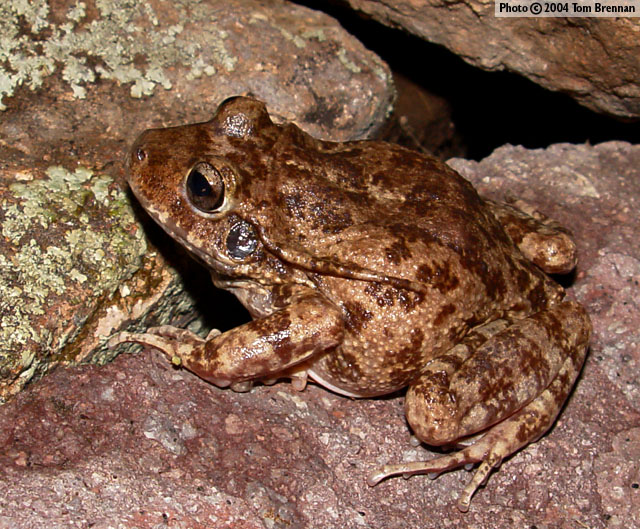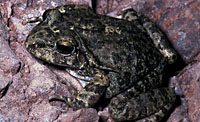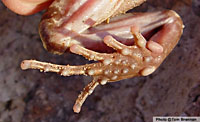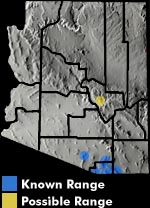Online Field Guide to The Reptiles and Amphibians of Arizona



Pajarito Mts. Santa Cruz County, Arizona
 Sonora Mexico |
| BARKING FROG Craugastor augusti | |
|
DESCRIPTION: To about 3.75 inches in length, adults of this toad-like frog are olive-gray to rusty-gray with dark irregularly shaped spots or blotches. The barking frog is distinguished from other Arizona anurans by a fold of skin across the back of the head (intertympanic fold) and tubercles on the feet. The toes are not webbed. Females are larger than males and have pink tympana and white throats year-round, while males have dark tympana, and adult males have a dark throat in the breeding season. Small juvenile frogs can look like the adults or may have large black patches on the head and lower body. DISTRIBUTION: The barking frog is known from rocky outcrops in the Santa Rita, Patagonia, Huachuca, Pajarito, and Quinlan mountains of Arizona. The species potentially occurs in other southeastern Arizona mountain ranges, and should be looked for in the Peloncillo, Mule, Whetstone, and Baboquivari mountains. An old report of the species from Parker Canyon in the Sierra Anchas of central Arizona is unsubstantiated. HABITAT: Barking frogs are found in outcrops or caves on rocky slopes in often scrubby oak or pine-oak woodlands at elevations of about 4,200-6,200 feet. Habitats are characterized by outcrops of limestone, rhyolite, granite, and perhaps other rock types with deep fissures, holes, and caverns where barking frogs can escape climatic extremes. BEHAVIOR: There is evidence that in Arizona this species may exhibit complex courtship behavior, including males leading females from aestivation sites to breeding locales. Females likely stay with the eggs until they hatch, and may help maintain egg moisture levels by excretion. REPRODUCTION AND CALLS: This frog is very difficult to find; most are located by their distinctive and loud “Walk! Walk!” call, which is made from rock outcrops at the beginning of the monsoons. Frogs call dependably for only two or three nights following the first heavy monsoon storm of the season, but may be heard sporadically for another 2-4 weeks. Unlike other frogs and toads in Arizona, this species lacks an aquatic larval stage – the young frogs hatch directly from the eggs. Barking frogs lay clutches of 50-76 eggs, presumably deep in moist rock crevices, outcrops, or caves, which hatch in about 20-35 days. DIET: Barking frogs eat crickets, grasshoppers, katydids, silverfish, scorpions, and a variety of other invertebrates. In captivity they have eaten cliff chirping frogs. REMARKS: Unless one is in the right place at the right time, this species can be nearly impossible to locate. In the Pajarito and Santa Rita mountains, as much as 39 and 45 years, respectively, have passed between finding specimens of this elusive frog. This is the only Arizona representative of the family Leptodactylidae, which includes over 500 species of tropical frogs. The barking frog often appears in the recent literature as Eleutherodactylus or Hylactophryne augusti. Barking frogs from Arizona differ in several ways from those in New Mexico and Texas and may be a different subspecies or species. By Jim Rorabaugh
Goldberg, C. 2003. Barking frog, Eleutherodactylus augusti (Dugés, 1879 in Brocchi, 1882). Sonoran Herpetologist 16(7):54-56. Goldberg, C.S., and C.R. Schwalbe. 2004. Habitat use and spatial structure of a barking frog (Eleutherodactylus augusti) population in southeastern Arizona. Journal of Herpetology 38(3):305-312. Goldberg, C.S., B.K. Sullivan, J.H. Malone, and C.R. Schwalbe. 2004. Divergence among barking frogs (Eleutherodactylus augusti) in the Southwestern United States. Herpetologica 60(3):312-320. Schwalbe, C.R., and C.S. Goldberg. 2005. Eleutherodactylus augusti (Dugés, 1879), Barking frog. Pages 491-492 in M.J. Lannoo (ed), Amphibian Declines: The Conservation Status of United States Species. University of California Press, Berkeley, CA. Zweifer, R.G. 1956. A survey of the frogs of the augusti group, genus Eleutherodactylus. American Museum Novitates 1813:1-35 |
|
Visit Partners in Amphibian and Reptile Conservation:


HOME
Copyright © 2023, Arizona Game and Fish Department. All rights reserved.
If you make use of the textual contents of this site in reports, publications, etc. please cite and credit the author(s) and photographer(s). All photos on this website are copyrighted. However, those found in the species account section may be used for any noncommercial scientific, educational, or conservation purposes provided that photographs are not altered and continue to bear the copyright symbol and name of the photographer. Please contact the photographer regarding commercial use of copyrighted photographs.











